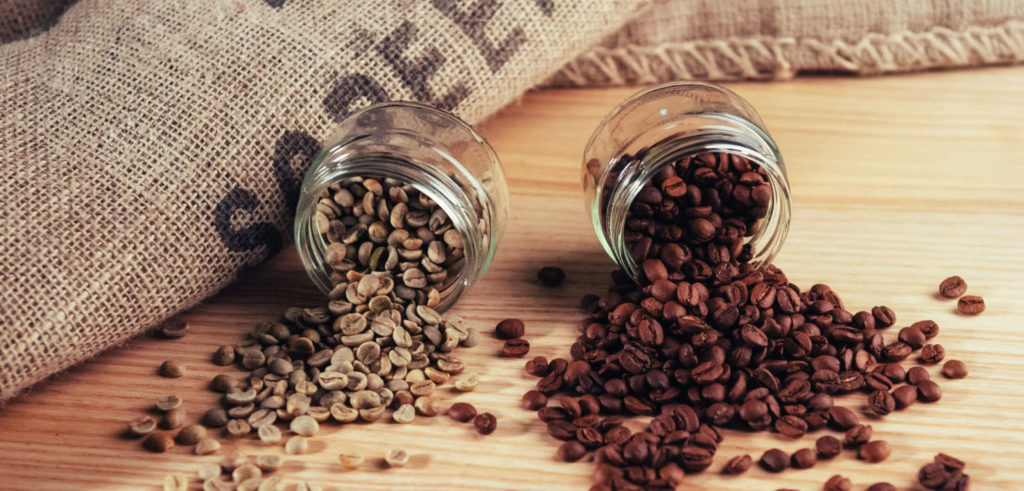
Differences between light roast and dark roast coffee beans go beyond color. You may have already learned longer roasting times give dark roast coffee beans their almost black color.
Besides roasting times and darker color, what are the distinguishing characteristics of light roast vs. dark roast coffee beans?
Let’s dig a little deeper to better understand how varying roasting times bring out differences in roasted coffee beans.
Dark Roast Coffee Beans Are More Full-Bodied and Have Bolder Flavors
What does it mean when coffee is “full-bodied”?
Let’s take a step back and define “body” as it relates to brewed coffee. Body is a characteristic describing the feeling or weight of a drink in one’s mouth. It is therefore sometimes known as “mouthfeel”. It can be described with words such as thin, light, heavy, or full. For comparison, whole milk has a heavier or fuller body, while skim milk has a thinner or lighter one. Some find the best way to get a sense of a coffee’s body is to let it rest on your tongue and rub it against the roof of your mouth.
The longer roasting time of dark roast coffee beans produces oils on the exterior. You may have noticed dark roast beans’ shinier surface. When brewed, these oils create the thicker, more full-bodied texture of dark roast coffee.
So is the darkest roast the most “full-bodied”?
In general, dark roast is more full-bodied relative to light roast coffee. However, coffee beans begin to lose body at a certain roasting point. Medium dark roasts tend to have the fullest, while darker roast beans have less body.
Darker roast coffees are known to have stronger and more distinct flavor profiles.
Check out green coffee beans that are great dark roast candidates.
What is a flavor profile?
A flavor profile describes the relative intensity of aromas, tastes, and aftertastes in a food. Flavor profiles can also be related to textures and sensory attributes. Therefore, it is often mentioned when referring to the “body” of a drink.
In comparison, the flavor of light roast coffees is usually described as sweeter and brighter. When coffee is described as bright, it refers to the higher levels of acidity and “tanginess”. A bright flavor also indicates a drier aftertaste.
Learn more about the body, flavor profiles, and other taste qualities of good coffee.
Light Roast Coffee Retains More of the Original Tastes of the Bean Relative to Dark Roast Coffee
Coffee beans’ origins play a role in the resulting flavor of brewed coffee. Each growing region will produce coffee beans with distinct flavor characteristics. The longer the beans are roasted, the more these flavors are masked. Higher quality coffees are sold as light roasts so unique flavors of different regions can be fully enjoyed.
Here are some examples of coffee growing regions and the flavor profiles associated with the coffee beans produced there:
- Ethiopia – Bright, complex, fruity
- Kenya – Acidic, sweet, notes of berry
- India – Smooth, creamy, mild
- Indonesia – Low Acidity, deep earthy flavors
- Brazil – Chocolatey, nutty, light acidity
- Colombia – Varies greatly region to region; from smooth with a chocolate finish to bright and fruity
Learning more about regional variations will help you select your favorite coffee.
If you are looking for coffee with a more complex taste, stick with light roast coffee beans. A complex flavored cup of coffee will reward you with many different taste accents.
Experiment with different roast levels and regional coffees. Bundle specials offer green coffee beans usually from different regions.
Both Light and Dark Roast Coffees Have Health Benefits, But They Differ
Recently there has been a great deal of research devoted to identifying the health benefits of coffee. In general, research has found some evidence that coffee consumption reduces the risk of liver cancer, Type 2 diabetes, and heart failure. Studies have also found drinking coffee lowers your risk of experiencing depression or suffering from Alzheimer’s or Parkinson’s disease.
But is light roast coffee healthier than dark roast coffee?
This is not necessarily the case. Research has found both to have health benefits.
Lighter roast coffees have a higher concentration of an antioxidant known as polyphenol chlorogenic acid (CGA). This antioxidant is what creates the acidic taste of coffee. CGA is the main component responsible for coffee’s health benefits. Because it’s an antioxidant, it has the ability to help reduce inflammation, cholesterol levels, and blood pressure. It can also help fight the signs of aging in your skin. Less CGA is present in darker roasts as it gets broken down during the roasting process. Note that the quality of the original (green) coffee bean contributes to the CGA level as well. High quality organic green coffee beans will have the highest level of CGA.
What are the health benefits of darker roast coffees?
Darker roast coffees have their health benefits as well. N-methylpyridinium is present in higher levels the longer the coffee beans are roasted. Research has shown this chemical reduces the amount of excess acid produced in the stomach. Those who experience stomach irritations when drinking coffee are likely better off selecting coffee brewed with darker roast beans.
The longer the roasting time, the more phenylindanes are produced in the coffee beans. Phenylindanes are the result of the chemical breakdown of chlorogenic acid lactone. They are responsible for the bitter taste of dark roast coffee. Despite the bitter taste, Phenylindanes are healthy for the brain. They prevent the buildup of proteins responsible for conditions related to the nervous system’s deterioration. These conditions include Alzheimer’s and Parkinson’s disease.
Compared to light roast, dark roast coffee has also been found to more effectively replenish vitamin E and glutathione in the blood. Vitamin E helps to protect cells from damage. It is also an important antioxidant that keeps the immune system strong. This antioxidant is also thought to play a role in lowering the risk of heart disease, cancer, and dementia. When your body produces healthy levels of glutathione, your body experiences many health benefits. These include reduced inflammation, deceleration of aging, and the prevention of mental health conditions.
The Caffeine Myth – Dark Roast vs. Light Roast Coffee
It is worth mentioning the caffeine levels in dark roast vs. light roast coffee. It was once believed that dark roast coffee contains more caffeine than light roast. However, this is not the case. The roasting process reduces the density of the coffee bean, but not the caffeine content.
If you are a decaf coffee drinker, you may be interested in learning how decaffeinated coffee beans are processed and roasted.
Browse the selection of decaffeinated green coffee beans from a variety of regions.
Personal taste and preference will likely play a large role when choosing between dark roast vs. light roast coffees. Be sure to try coffee beans from different regions. Roast these beans at varying levels before making your final decision. You may be delightfully surprised.
Compare a variety of home coffee roasters and review The Ultimate Guide to Home Roasting Coffee Beans to begin your home coffee roasting journey.




Thanks…..good info! I’m not too fond of the flavor profiles of light or medium roast coffees, it’s a medium dark to dark roast for me I’ve been roasting my coffee for 20-plus years.